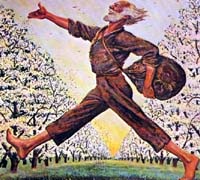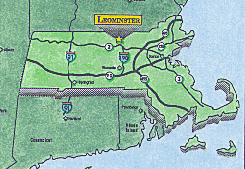

|
(1972 Postcard of Commemorative Stamp...
Click HERE for back of postcard)


|

|
 Johnny Appleseed, real name John Chapman, was born in Leominster, Massachusetts, September 26th, 1774 to Nathaniel Chapman and Elizabeth Symond Chapman. Nathaniel Chapman, was one of the Minutemen who fought at Concord on April 19, 1775, and later in the Continental Army during the Revolutionary War. Johnny's Mother had three children: Elizabeth born in 1770, John, and Nathaniel Jr who died shortly after birth in 1776. His mother was sick from tuberculosis and died three weeks after her third child. It is reasonable to assume that Elizabeth's parents took care of John and his sister while their father was in the Army. John's father married Lucy Cooley of Longmeadow, MA in 1780 and had a family of ten children. Johnny and Elizabeth lived with them for some time in Longmeadow. Johnny was an almost legendary character and nature lover of the frontier days in the Middle West. Very little is known about his everyday life.
Johnny Appleseed, real name John Chapman, was born in Leominster, Massachusetts, September 26th, 1774 to Nathaniel Chapman and Elizabeth Symond Chapman. Nathaniel Chapman, was one of the Minutemen who fought at Concord on April 19, 1775, and later in the Continental Army during the Revolutionary War. Johnny's Mother had three children: Elizabeth born in 1770, John, and Nathaniel Jr who died shortly after birth in 1776. His mother was sick from tuberculosis and died three weeks after her third child. It is reasonable to assume that Elizabeth's parents took care of John and his sister while their father was in the Army. John's father married Lucy Cooley of Longmeadow, MA in 1780 and had a family of ten children. Johnny and Elizabeth lived with them for some time in Longmeadow. Johnny was an almost legendary character and nature lover of the frontier days in the Middle West. Very little is known about his everyday life.

|
 John Chapman headed west about 1800. Known as Johnny Appleseed, he carried with him apples for planting, usually along streams (probably obtained seeds from cider mills in Pennsylvania). His earliest known apple nursery was planted near Steubenville, Ohio, in a valley near the Ohio River. He located them near settlements where he could walk back and forth to maintain them. He was a practical nurseryman, not a 'scatterer of seeds' as people believed and owned several orchards. He lived the rest of his life in Ohio and Indiana, wandering about barefoot, clad in rags ('wearing a tin kettle on his head', they say), tending the apple orchards he started wherever he found a good spot, and reading aloud from the Bible. He walked alone without gun or knife. He chopped down no trees and killed no animals. He lived very simply. He slept outdoors, ate berries and made his clothes from sacks. He made his drinking water in winter by melting snow with his feet. For Forty-nine years he roamed the American wilderness, devotedly planting apple trees. He created apple orchards in the wildernesses of Pennsylvania, Ohio, Kentucky, Illinois and Indiana, spanning an estimatd area of 100,000 square miles. Some of these trees are still bearing fruit after 150 years.
John Chapman headed west about 1800. Known as Johnny Appleseed, he carried with him apples for planting, usually along streams (probably obtained seeds from cider mills in Pennsylvania). His earliest known apple nursery was planted near Steubenville, Ohio, in a valley near the Ohio River. He located them near settlements where he could walk back and forth to maintain them. He was a practical nurseryman, not a 'scatterer of seeds' as people believed and owned several orchards. He lived the rest of his life in Ohio and Indiana, wandering about barefoot, clad in rags ('wearing a tin kettle on his head', they say), tending the apple orchards he started wherever he found a good spot, and reading aloud from the Bible. He walked alone without gun or knife. He chopped down no trees and killed no animals. He lived very simply. He slept outdoors, ate berries and made his clothes from sacks. He made his drinking water in winter by melting snow with his feet. For Forty-nine years he roamed the American wilderness, devotedly planting apple trees. He created apple orchards in the wildernesses of Pennsylvania, Ohio, Kentucky, Illinois and Indiana, spanning an estimatd area of 100,000 square miles. Some of these trees are still bearing fruit after 150 years.

|
 The seeds that he planted, and the saplings he gave away (see below paragraph) to the local Indians and the new settlers, helped to build the orchards of the Midwest. Apples were very important to the early settlers. They offered something different in what could become boring daily meals. Easy to grow and store for year-round use, they were dried to eat during the winter, and made into butter and cider. Chapman also planted the seeds of many healing herbs such as catnip, horehound, and pennyroyal. Some could say that he planted spiritual seeds as well. Despite his eccentric appearance, he was regarded as a healer, and even something of a saint, by settlers and Indians alike.
The seeds that he planted, and the saplings he gave away (see below paragraph) to the local Indians and the new settlers, helped to build the orchards of the Midwest. Apples were very important to the early settlers. They offered something different in what could become boring daily meals. Easy to grow and store for year-round use, they were dried to eat during the winter, and made into butter and cider. Chapman also planted the seeds of many healing herbs such as catnip, horehound, and pennyroyal. Some could say that he planted spiritual seeds as well. Despite his eccentric appearance, he was regarded as a healer, and even something of a saint, by settlers and Indians alike.

|
 Johnny Appleseed didn't wander the Midwest giving away apple seedlings and seeds, as many believe.
In 1806 Johnny charged about 6 cents for a seedling. But if setters couldn't pay, they say he would accept cornmeal, old clothes or a promise to pay in the future. He probably gave trees to needy families.
Johnny Appleseed was not a poor man, he was a businessman. He had money, but he used it for charity and to further his work rather than for his personal comfort.
Johnny Appleseed didn't wander the Midwest giving away apple seedlings and seeds, as many believe.
In 1806 Johnny charged about 6 cents for a seedling. But if setters couldn't pay, they say he would accept cornmeal, old clothes or a promise to pay in the future. He probably gave trees to needy families.
Johnny Appleseed was not a poor man, he was a businessman. He had money, but he used it for charity and to further his work rather than for his personal comfort.
 John Chapman was a deeply religious man and a self-appointed missionary for the Church of the New Jerusalem, a Christian Church based on the Biblical interpretations of Emanuel Swedenborg. His love for his neighbors made him a peacemaker between the Indians and the settlers.
John Chapman was a deeply religious man and a self-appointed missionary for the Church of the New Jerusalem, a Christian Church based on the Biblical interpretations of Emanuel Swedenborg. His love for his neighbors made him a peacemaker between the Indians and the settlers.

|
 John Chapman died of pneumonia, often called the 'winter plague', on March 18th, 1845, at the age of 70, in the home of his old Richland County, OH friend, William Worth. He was buried a few miles north of Ft. Wayne, Indiana, at a 12-acre grave site, which was designated "The Johnny Appleseed Memorial Park" through a gift by Mr. and Mrs. William T. McKay. The inscription on the grave stone read, "Johnny Appleseed (John Chapman) He lived for others. 1774-1845"
John Chapman died of pneumonia, often called the 'winter plague', on March 18th, 1845, at the age of 70, in the home of his old Richland County, OH friend, William Worth. He was buried a few miles north of Ft. Wayne, Indiana, at a 12-acre grave site, which was designated "The Johnny Appleseed Memorial Park" through a gift by Mr. and Mrs. William T. McKay. The inscription on the grave stone read, "Johnny Appleseed (John Chapman) He lived for others. 1774-1845"
 The City of Leominster, Massachusetts is proud of being the birthplace of John Chapman, known as Johnny Appleseed. They celebrate with a parade in his honor every year. They have also named one of their Schools, Johnny Appleseed Elementary School in North Leominster, after this legendary character. They also have a monument dedicated to him on Johnny Appleseed Lane, the place of his birth, and a statue in front of the Library. Johnny Appleseed Birth Certificate & Worcester Telegram Articles
The City of Leominster, Massachusetts is proud of being the birthplace of John Chapman, known as Johnny Appleseed. They celebrate with a parade in his honor every year. They have also named one of their Schools, Johnny Appleseed Elementary School in North Leominster, after this legendary character. They also have a monument dedicated to him on Johnny Appleseed Lane, the place of his birth, and a statue in front of the Library. Johnny Appleseed Birth Certificate & Worcester Telegram Articles

|
Leominster High School Band Marches in Johnny Appleseed Parade, September 1999.
Appleseed Alley...Story and Many Great Links about Johnny Appleseed..
Johnny Appleseed by Marji Hazen.
History and Legends of Apples...Eveything you always wanted to know!

'Search for any Name/Word's on our site'
  Maureen and Jim Tansey |
Leominster, MA
Time & Temperature
![]()

Leominster Historical Commission, City Hall, 25 West St, Leominster, MA 01453
Johnny Appleseed Visitor Center, Rt 2, (Between Exits 34 & 35, Lancaster, MA (978.534.2302) johnny@appleseed.org
Fitchburg Sentinel & Leominster Enterprise
Worcester Telegram, Worcester MA
The Life of Johnny Appleseed, Caldwell School, Rt 58, Northwest PA (between Mercer & Greenville), BillWedemeyer,weeds@msc.cornell.edu
Judy Zehner & Sara Thena, Johnny Appleseed Festival Inc, P.O.Box 80127, Ft Wayne, IN 46898-0127, jbaxter@fwi.com - Tel 219.427.6003

|